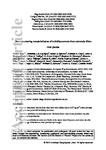Direct monitoring reveals initiation of turbidity currents from extremely dilute river plumes
| dc.contributor.author | Hage, S | |
| dc.contributor.author | Cartigny, MJB | |
| dc.contributor.author | Sumner, EJ | |
| dc.contributor.author | Clare, MA | |
| dc.contributor.author | Hughes Clarke, JE | |
| dc.contributor.author | Talling, PJ | |
| dc.contributor.author | Lintern, DG | |
| dc.contributor.author | Simmons, SM | |
| dc.contributor.author | Silva Jacinto, R | |
| dc.contributor.author | Vellinga, AJ | |
| dc.contributor.author | Allin, JR | |
| dc.contributor.author | Azpiroz‐Zabala, M | |
| dc.contributor.author | Gales, Jenny | |
| dc.contributor.author | Hizzett, JL | |
| dc.contributor.author | Hunt, JE | |
| dc.contributor.author | Mozzato, A | |
| dc.contributor.author | Parsons, DR | |
| dc.contributor.author | Pope, EL | |
| dc.contributor.author | Stacey, CD | |
| dc.contributor.author | Symons, WO | |
| dc.contributor.author | Vardy, ME | |
| dc.contributor.author | Watts, C | |
| dc.date.accessioned | 2019-09-20T11:08:08Z | |
| dc.date.available | 2019-09-20T11:08:08Z | |
| dc.date.issued | 2019-09-13 | |
| dc.identifier.issn | 0094-8276 | |
| dc.identifier.issn | 1944-8007 | |
| dc.identifier.other | 0 | |
| dc.identifier.uri | http://hdl.handle.net/10026.1/14929 | |
| dc.description.abstract |
<jats:title>Abstract</jats:title><jats:p>Rivers (on land) and turbidity currents (in the ocean) are the most important sediment transport processes on Earth. Yet how rivers generate turbidity currents as they enter the coastal ocean remains poorly understood. The current paradigm, based on laboratory experiments, is that turbidity currents are triggered when river plumes exceed a threshold sediment concentration of ~1 kg/m<jats:sup>3</jats:sup>. Here we present direct observations of an exceptionally dilute river plume, with sediment concentrations 1 order of magnitude below this threshold (0.07 kg/m<jats:sup>3</jats:sup>), which generated a fast (1.5 m/s), erosive, short‐lived (6 min) turbidity current. However, no turbidity current occurred during subsequent river plumes. We infer that turbidity currents are generated when fine sediment, accumulating in a tidal turbidity maximum, is released during spring tide. This means that very dilute river plumes can generate turbidity currents more frequently and in a wider range of locations than previously thought.</jats:p> | |
| dc.format.extent | 11310-11320 | |
| dc.format.medium | Print-Electronic | |
| dc.language | en | |
| dc.language.iso | en | |
| dc.publisher | American Geophysical Union | |
| dc.title | Direct monitoring reveals initiation of turbidity currents from extremely dilute river plumes | |
| dc.type | journal-article | |
| dc.type | Journal Article | |
| plymouth.author-url | https://www.ncbi.nlm.nih.gov/pubmed/31894170 | |
| plymouth.issue | 20 | |
| plymouth.volume | 46 | |
| plymouth.publication-status | Published | |
| plymouth.journal | Geophysical Research Letters | |
| dc.identifier.doi | 10.1029/2019gl084526 | |
| plymouth.organisational-group | /Plymouth | |
| plymouth.organisational-group | /Plymouth/Faculty of Science and Engineering | |
| plymouth.organisational-group | /Plymouth/Faculty of Science and Engineering/School of Biological and Marine Sciences | |
| plymouth.organisational-group | /Plymouth/REF 2021 Researchers by UoA | |
| plymouth.organisational-group | /Plymouth/REF 2021 Researchers by UoA/UoA07 Earth Systems and Environmental Sciences | |
| plymouth.organisational-group | /Plymouth/Users by role | |
| plymouth.organisational-group | /Plymouth/Users by role/Academics | |
| dc.publisher.place | United States | |
| dcterms.dateAccepted | 2019-09-02 | |
| dc.rights.embargodate | 2020-3-12 | |
| dc.identifier.eissn | 1944-8007 | |
| dc.rights.embargoperiod | Not known | |
| rioxxterms.versionofrecord | 10.1029/2019gl084526 | |
| rioxxterms.licenseref.uri | http://www.rioxx.net/licenses/all-rights-reserved | |
| rioxxterms.licenseref.startdate | 2019-09-13 | |
| rioxxterms.type | Journal Article/Review |


